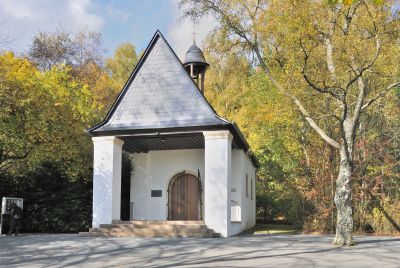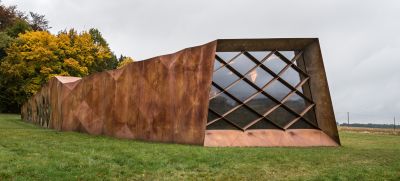Polish victims in the Hinzert SS concentration camp

The Hinzert SS special camp/concentration camp in the National Socialist camp system
Alongside the “Eindeutschungspolen” (“re-germanised Poles”) who were deployed in special “Pole labour groups”, there were large number of other groups of prisoners who were interned in the Hinzert SS special camp/concentration camp. Initially, in 1938, Hinzert was built as a camp complex for workers who were conscripted to work on construction of the “West Wall” or the Reichsautobahn. However, in 1939, other people were already being brought to the Hinzert “work education camp” due to work-related “offences”, while the camp also functioned as a “police internment camp” and an “SS special camp”. From the start, Hinzert fulfilled a trans-regional function, with other, newly-established police internment camps for offending workers being subordinated to the camp commander of the Hinzert SS special camp. This system of “west camps” already became obsolete in 1939/1940 as the Wehrmacht advanced through western Europe. On 1 July 1940, the camp was subordinated to the concentration camp inspectorate in Oranienburg, which by February/March 1942 was in turn incorporated into the newly created SS Main Economic and Administrative Office (SS-Wirtschafts-Verwaltungshauptamt). The SS men and guard squads were subsumed by the Waffen-SS. From that time on, Polish prisoners were brought to Hinzert from the European countries occupied by Germany in increasing numbers. In the SS Main Economic and Administrative Office, the work conducted by the prisoners was assigned entirely to serving the war economy, right through to “extermination through labour”. In the vast majority of cases, the work was performed in subcamps, sometimes under the most adverse conditions. Here, as in the main camps, sadistic harassment and maltreatment by the camp guards were an everyday occurrence. From mid-1944 onwards, a network of satellite camps was developed which extended beyond the subcamps.[1]
It became the central camp for the Luxembourg Résistance. From May 1942 onwards, political prisoners arrested under the terms of the “Night and Fog Decree” of 7 December 1941 were brought to Hinzert from France. There were 2,000 such prisoners in all, and included resistance fighters from the Netherlands, Belgium and Luxembourg as well as France. The female “night and fog prisoners” were taken temporarily to the Flussbach women’s detention camp near Wittlich (now in Rhineland-Palatinate). Three times, groups of prisoners were brought to Hinzert solely for the purpose of executing them. This occurred in mid-October 1941, when 70 Soviet prisoners were executed in what was the largest case of mass murder in Hinzert. In September 1942, 20 Luxembourgers were executed in Hinzert, as were 23 Luxembourgers in February 1943. They were buried in shallow graves in the forest. In total, at least 13,600 men from 20 countries were deported to Hinzert between September 1939 and March 1945.[2] Overall, 321 people are known to have died in Hinzert, although various sources indicate that the actual number is in fact far greater, and that it has not been possible to locate the remains of all the victims.[3] To date, it remains unclear how many of them were Poles. In 2003, Volker Schneider, a teacher from Hermeskeil who has worked for decades to uncover the history of Hinzert, recorded what prisoners remembered about the murders and the burial of the bodies in shallow graves as follows:
“From 1943 onwards, the existence of mass graves in the semi-official prisoners’ cemetery was known to nearly every camp inmate, and were called ‘Little Katyn’, as prisoners who are still alive today [2003] can confirm”.[4]
[1] Bader, Uwe; Welter, Beate: Das SS-Sonderlager/KZ Hinzert, in: Benz, Wolfgang; Distel, Barbara (eds.): Der Ort des Terrors. Geschichte der nationalsozialistischen Konzentrationslager. Vol. 5: Hinzert, Auschwitz, Neuengamme, München 2007, p. 17–74, here p. 17–22, 33f [satellite camps: p. 43–74]. For a list of satellite and subcamps with basic data, see https://memorial-archives.international/entities/show/56bbb586759c0241b94067e6 (12/1/2022).
[2] Bader, Uwe; Welter, Beate: Das SS-Sonderlager/KZ Hinzert, in: Benz, Wolfgang; Distel, Barbara (eds.): Der Ort des Terrors. Geschichte der nationalsozialistischen Konzentrationslager . Vol. 5: Hinzert, Auschwitz, Neuengamme, München 2007, p. 17–74, here p. 23–30.
[3] Ibid., p. 35.
[4] Schneider, Volker: Oberkapo Eugen Wipf. “… ein Scheusal in Menschengestalt”. Zu einem KZ-Verfahren in der Schweiz im Zusammenhang mit dem ehemaligen Konzentrationslager “SS-Sonderlager Hinzert”, online publication [Neuhütten 2003], p. 80: https://studylibde.com/doc/9134586/oberkapo-eugen-wipf---des-gymnasiums-hermeskeil (12/1/2022). The name was likely used by SS staff and prisoners from the spring of 1943 onwards – ibid. p. 128.









